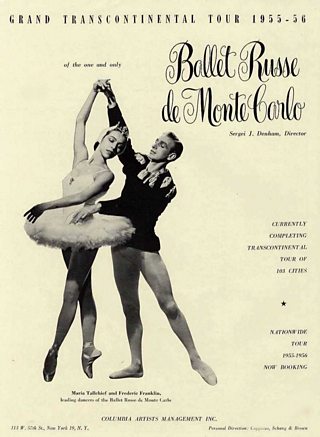The ballerina who stood up to the Ku Klux Klan

As part of Oti Mabuse’s Dancing Legends series on Βι¶ΉΤΌΕΔ Radio 4, the dancer, trainer and twice winner of Strictly Come Dancing meets American dance superstar Misty Copeland, one of the most recognisable faces of modern ballet and the first African-American female principal dancer in her company, American Ballet Theatre.
Each of Oti’s subjects in the series is asked to name their dance hero – Misty chooses Raven Wilkinson (1935-2018), one of the first African-Americans to dance with a major classical ballet company.
Both Misty and Raven faced many challenges in their careers because of their racial identity. Though expressed in different ways, these challenges affected them in a similar way, making them more determined to make the most of their opportunities and represent their ancestors and also the generations to come.
Love at first sight
Born in New York in 1935, Raven Wilkinson’s first experience of ballet was when her mother took her to see the Ballet Russe de Monte Carlo. Raven was just five years old, and her reaction was one of huge excitement and tears of joy. It became her dream to dance with the company.

Raven showed that Black dancers could 'lead with empathy and love'.Misty Copeland
That dream was realised when the dance school Raven had later joined in New York was bought by the Ballet Russe. She auditioned several times and, when successful, it was ballet impresario and the director of the company Sergei Denham who told her she was in.
"I'm American"
Raven was used to people asking questions about her racial identity. “People always thought we were Indonesian or Spanish or something exotic, and they were forever asking ‘excuse me, could you tell me what you are?’ And my mother would say, ‘I'm American.’”
“It's a part of my life, and it's not embarrassing to me,” Raven explained in an interview.
However, Raven’s acceptance into the Ballet Russe happened in 1955, at a time of heightened racial tensions and continuing segregation.
Denham asked Raven not to make people aware she was black, even asking her parents to reinforce this. Raven made it clear that she wouldn’t lie if asked, “and that made me a problem.”
A life on the line
The attempt to hide Raven’s racial identity didn’t succeed in preventing unwanted attention, and she faced frequent death threats.
On one occasion, the white supremacist Ku Klux Klan group stormed a Ballet Russe production at a theatre in Alabama, demanding that the cast expose her. The cast stood firm in the face of this terrifying intimidation and the Klan members left.
Breaking Point
The Ballet Russe faced a number of incidents of the kind described above. Eventually, after a long time supporting her, the situation became untenable to them.
Raven was prevented from performing in some places because of the safety fears around her. One of the ballet mistresses told Raven that her career in ballet would go no further and that she should consider leaving to start a school of African dance instead.
In 1961, Raven had also reached breaking point. She had been driven and determined in the face of the racist threats, but she was also exhausted by them. She left the company and quit dancing for a few years.

Raven Wilkinson: Pioneering African-American ballet dancer
Raven Wilkinson defied white supremacists in the 1950s to become a professional dancer
Belated icons
Despite the strife offstage, Raven’s achievements on it were massive. She performed in key works such as Tchaikovsky's Piano Concerto No.2 and Swan Lake, and she made the waltz solo from Chopin’s Les Sylphides her own.

Misty also performed this role, half a century later, but it wasn’t something she could take for granted. In fact many of the classical roles like Juliet in Romeo and Juliet, Odile in Swan Lake and Aurora in Sleeping Beauty were ones that Misty didn’t experience until later in her career.
“Most white dancers, I would say, if they're on that track to become a principal dancer, experienced that in their early twenties. I was in my mid- to late thirties.”
A wind of change
Raven was a huge influence on Misty and would call Misty before every performance. “She would always say to me ‘let me be the wind at your back when you perform’.”
The support was very welcome because Misty felt an extra responsibility when she was performing. “I felt like I had this weight – and not in a negative way – to do the best I could to carry my ancestors with me.”
Raven’s style was romantic and soft but powerful at the same time, and she was key to breaking down conceptions of black dancers as simply just strong and fierce. In Misty’s words Raven showed that black dancers could “lead with empathy and love.”
“It’s so emotional to think of,” says Misty. “She's no longer with us, but she makes me think about, not just her, but all the Black dancers who have paved the way for this generation… and that's what keeps me going. If Raven could go through that, I can definitely do this.”
-
![]()
Oti Mabuse's Dancing Legends: Raven Wilkinson
Oti sits down with one of the most recognisable faces of modern ballet – Misty Copeland. Misty became the first African American female Principal Dancer at the American Ballet Theatre company. She reflects on her inspiration, Raven Wilkinson, who danced 50 years before her.

Dancing on Radio 4
-
![]()
Oti Mabuse's Dancing Legends
Professional dancer Oti Mabuse explores the extraordinary people who have changed the course of dance.
-
![]()
Great Lives: Fred Astaire
Dr Michael O'Donnell discusses celebrated singer, actor and choreographer Fred Astaire.
-
![]()
The Strictness of Ballroom
Dancer and broadcaster Deborah Bull on the emergence of dance as a competitive activity.
-
![]()
Short cuts – Dancing on the Radio
Josie Long presents toe-tapping, choreographed short documentaries offering three adventures in sound about dancing.





